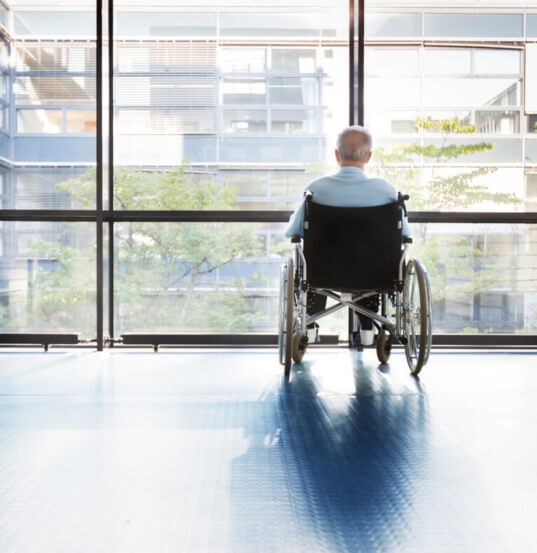Comprehensive Guide to Senior Living & Housing

One of the most important concerns for seniors is what their living arrangements will look like as they age. Traditionally, seniors had three options for housing once their physical health began to deteriorate: remain at home, live with a child or other relative, or enter a nursing home.
Today, your or your loved one’s options are not so limited. In fact, there are so many options for senior living arrangements that it can be bewildering at times. However, most decisions regarding living options for seniors will be based on one or more of the following considerations (and, often times, more):
- The level of care needed
- The facility’s location and logistical considerations (proximity to friends, family, church, etc.)
- The cost of the facility
Whatever your requirements are, however, there is an ideal living arrangement for you or your loved one.
For a printable version of this document, click here.
Common Options for Senior Living and Housing

Aging in Place
Aging in place is exactly what it sounds like — it is an arrangement whereby a senior remains in their own home or in a relative’s home. It offers a number of benefits, the primary of which is that the senior can remain in an environment they know and in which they are comfortable. Other benefits include the ability to exercise a great deal of control over their environments, proximity to friends and family members, and easy access to familiar locations (houses of worship, stores, restaurants, etc.).
Seniors aging in place typically rely upon in-home healthcare workers or family members to assist with their activities of daily living. While aging in place may require some minor home modifications (ramps, bathroom grab rails, medical alert systems, etc.), it is generally a low-cost option. It is ideal for seniors who are relatively independent with light to moderate medical needs.
In-Home Senior Care
An increasingly popular form of senior living is in-home senior care, in which an individual remains in their home, but hires a trained medical professional to provide assistance with their activities of daily living. Such care can range from occasional check-ins to 24/7 live-in help. While in-home senior care allows seniors to age in place even when they require more care than an independent individual, this type of living arrangement is not without drawbacks. For example, the cost of an in-home health aide increases commensurately with the level of care the individual requires.
Many seniors may not feel comfortable welcoming a stranger into their home and giving them potentially unlimited authority to regulate their daily activities. Additionally, in-home caregivers can easily become exasperated or overburdened, which may lead to a diminished quality of care and create fertile ground for exploitation or abuse.
The Village Model
The village model of senior living is a type of aging-in-place arrangement wherein neighbors and local businesses pool their resources to help each other stay in their homes as they grow older. While these types of villages do not provide services directly, they act as a liaison or concierge service. Typically, friends, family, able-bodied neighbors, and youth groups provide residents with the services they need. This can include cooking, cleaning, gardening and lawn care, bookkeeping, and transportation. Residents normally pay a small annual fee in return for these services.
Cohousing
Cohousing allows seniors to own their own private home, yet still obtain the benefits of communal living. These types of communities usually consist of homes that form a neighborhood or that are clustered around pools, parks, or community centers. Homeowners pay for their home plus a community fee (analogous to an HOA fee) that covers various amenities and services, but each resident retains responsibility for their own utilities, food, cable, internet, electricity, etc. Responsibility for decision making in cohousing communities can be made either cooperatively, by a top-down model, or through majority-rules voting.
Independent Living
Independent living refers to any living arrangement that is designed exclusively for seniors. A common form of independent living arrangement is the retirement community (also known as an age-restricted community or 55+ community), which consists of a variety of different housing styles to cater to many different needs, including single-family houses, duplexes, and condominiums. Many of these communities come with luxurious amenities, such as golf courses, swimming pools, clubhouses, and more. Another common form of independent living is the senior apartment, which in most cases consists of a single apartment or condominium building or small group of buildings that are limited to senior residents. Many senior apartment communities also offer recreational and social services, such as a dining room, pool, lounge, and transportation.
The costs of independent living vary greatly depending upon the amenities and services they offer. While some cater to the wealthy, others serve a broader population, and some are government-subsidized with income limits. Independent living arrangements are ideal for seniors who want to live in an active community among peers but without daily worries such as cooking, cleaning, and maintenance.
Congregational Retirement Communities
Congregational retirement communities function mostly the same way as secular retirement communities, but they are populated by individuals who share religious beliefs and a common congregational affiliation. These communities typically offer religious services beyond those offered by secular communities, such as priests, ministers, or rabies on staff; regular worship services; religious counseling; and faith-based speakers, activities, and events. As with secular retirement communities, the costs of congregational retirement communities vary; however, some such communities are supported at least partially by their religious organizations, which may reduce the costs for members of that organization. Congregational retirement communities are an ideal option for relatively independent individuals for whom faith plays an important role in their lives.
Assisted Living
Assisted living arrangements allow seniors to remain as independent as possible while still providing assistance with some or all of their activities of daily living, such as eating, bathing, getting dressed, and taking medication. As such, they blend the features of independent living with those of skilled nursing facilities, making them ideal for seniors who are unable to live completely independently but do not need full-time, around-the-clock care. Many assisted living facilities provide apartment-style living, but may also offer single-room and roommate-style accommodations for individuals who require more assistance. Some assisted living facilities also offer memory care — specialized treatment for individuals experiencing dementia, Alzheimer’s, and other mental deficiencies.
Many such facilities also offer the amenities of independent living communities, such as gyms, pools, cafeterias, and social programming. Assisted living facilities generally are less expensive than skilled nursing homes, and residents may pay for their services using a variety of funding sources.
Nursing Homes/Skilled Nursing Facilities
Nursing homes (also known as skilled nursing facilities) are a good option for seniors who need extensive assistance with their activities of daily living and frequent medical care, as they are staffed by medical professionals trained in caring for the elderly. While individual independence varies, nursing home residents generally are in medical recovery or have chronic health conditions that require long-term medical attention. Skilled nursing professionals provide assistance with most or all of their residents’ activities of daily living, including bathing, getting dressed, eating, mobility, physical therapy, and taking medication. A higher proportion of nursing home residents also suffer from Alzheimer’s when compared to more independent-style living situations.
Nursing homes typically are more expensive than senior apartments and assisted living communities due to their residents’ greater need for care and supervision. According to U.S. News and World Report, a private room in a nursing home costs an average of $8,365 per month in 2018. It is thus advantageous for seniors to obtain long-term care insurance well before the need arises.
Continuing Care Communities
Continuing care communities blend the features of independent living, assisted living, and skilled nursing facilities to provide a “continuum of care” as their residents age and their needs change. Typically, individuals in continuing care communities enter the community in an independent living setting, where they may have their own apartment, condo, or single-family house. When they find that completely independent living is no longer feasible, they may “age out” into an assisted living setting, where they will receive the appropriate level of care. Once assisted living is no longer feasible, they may then “age out” again into a skilled nursing setting.
Such communities offer a number of advantages to their residents. Chiefly, they set into motion an aging care plan early on, thus eliminating the need to iron out further details at later stages. Second, they are ideal for individuals who want to maintain an active social life, as their friends and neighbors will remain in the same community regardless of the level of care they need. Third, it allows married couples to remain together even if one of the seniors requires more advanced care than the other.
How to Pay for Senior Living

Choosing a living arrangement is not merely a question of selecting the model that best aligns with your physical needs; you must also consider each model’s cost and whether you will be able to comfortably pay for it. The cost of such care varies by where you live and how much assistance you need. In 2018, a one-bedroom unit in an assisted living facility averaged about $48,000 per year, and the price had risen an average of 3% a year over the previous five years. For nursing homes, the average price was $90,000 per year for a shared room and $100,000 for a private room. While you may have saved diligently for retirement and amassed a formidable 401(k), you may not have given as much thought to long-term care — which is not covered under Medicare.
When it comes to paying for senior living, there are a variety of options available to you, each of which is outlined below.
Out-of-Pocket Funds
Many individuals pay for long-term care at least partially out-of-pocket. Such funds can come from a variety of sources, including traditional savings accounts, 401(k)’s, pensions, stocks, bonds, and reverse mortgages. They can also come from children or other relatives who are able and willing to shoulder some of the costs for their family members’ long-term care.
Long-Term Care Insurance
Long-term care insurance is an insurance product that pays for long-term medical care needs that are not covered under regular health insurance or Medicare. But there are a lot of bad policies out there which seniors need to be aware of. Always do your due diligence on the policy and the carrier; you should check with the Department of Insurance to see if there have been any complaints against them. Also, do an online search of any long-term care insurance company suggested to you to see if they are reputable or if they have had a lot of claim denial complaints and lawsuits against them. In general, long-term care policies should reimburse you for care in a wide range of settings, such as:
- In your own home
- At an adult day care facility
- In an assisted living facility
- At a nursing home
When considering a long-term health insurance policy, it is important to act before you need it; a pre-existing debilitating medical condition can make you ineligible for long-term care insurance. The cost of long-term care insurance varies by individual and is based on a number of factors, such as your age and health, your gender, your marital status, and the amount of coverage you need. Generally, experts recommend spending no more than 5% of your income on a long-term care policy. Always have a professional with nothing to gain from the sale of a policy review any proposals before you buy long-term care coverage. And again, make sure to do your due diligence before you purchase any long-term care policy. There have been lots of coverage problems and claims denials over the years on many of these policies and as health care costs rise those problems are likely to increase.
Medicaid
Medicaid is a government program that provides health coverage to low-income individuals. Nationwide, Medicaid pays between 45% and 65% of all nursing home costs, making it the most common way individuals pay for long-term care. However, eligibility for the program is limited to individuals with low income and few assets, and eligibility requirements frequently change. But for individuals who qualify, Medicaid pays the full cost of room and board in skilled nursing facilities that accept Medicaid funding. Medicaid should not be confused with Medicare, another government program that provides health insurance to seniors. While Medicare covers short stays in skilled nursing facilities for individuals who require assistance recovering from a medical procedure, it does not pay for long-term care.
The Risks of Senior Living

Senior living arrangements such as assisted living communities and nursing homes are designed to meet their residents’ unique needs. However, elder care is not without risks. Elder abuse is widespread and residents of senior living facilities are particularly vulnerable to it. And as the American population continues to age, elder abuse is likely to become further widespread in the coming years.
Elder Abuse Is Common
Seniors (defined as adults aged 65 or older) now comprise almost 15% of the population of the United States, according to the U.S. Department of Justice, and projections anticipate that this percentage will continue to grow in the coming decades. The Justice Department estimates that at least 10% of seniors will experience some form of elder abuse in a given year, with many seniors experiencing multiple types of abuse. However, the true prevalence of elder abuse is actually much wider, given widespread underreporting. According to Justice Department statistics, the vast majority of elder abuse goes unreported:
- For caregiver neglect, there are an estimated 57 unreported cases for every reported case
- For financial exploitation, there are an estimated 44 unreported cases for every reported case
- For physical elder abuse, there are an estimated 20 unreported cases for every reported case
- For psychological abuse, there are an estimated 12 unreported cases for every reported case
The physical, emotional, and financial damage inflicted by elder abuse can have severe and long-term consequences for its victims.
What Is Elder Abuse?
“Elder abuse” is an umbrella term that encompasses a wide range of intentional behaviors that harm and exploit elderly individuals. The three primary forms of elder abuse are physical abuse, financial abuse, and psychological abuse.
Physical Abuse
Physical elder abuse consists of behavior that causes physical harm to the victim. It encompasses many forms of abusive behaviors, such as:
- Hitting
- Biting
- Pushing/shoving
- Hair-pulling
- Unjustified use of physical restraints
- Over- or under-medicating
- Intentionally failing to care for an injury
- Sexual abuse
Physical abuse can be particularly devastating to elderly individuals given that many such individuals are already in weakened physical states.
Financial Abuse
Financial abuse involves behaviors that are designed to harm elders financially, either through outright theft or by means of coercion, misrepresentation, or deception. Financial abuse is detrimental to all of its victims but can be particularly devastating to the elderly, as many such individuals have limited means and live on fixed incomes. Some common forms of financial elder abuse include:
- Theft: Occurs when the perpetrator steals cash, checks, or personal effects from the victim. It is particularly common in nursing homes and assisted living facilities.
- Probate fraud: Occurs when the perpetrator induces the victim to change his or her will in a way that will benefit the perpetrator
- Annuity fraud: Occurs when the perpetrator induces the victim to purchase an annuity that is unsuitable for senior citizens (such as those with lengthy withdrawal waiting periods)
- Securities fraud: Occurs when the perpetrator induces the victim to purchase a security that is either fictitious or high-risk
The elderly can become targets of financial abuse because of their advanced age, declining mental capacity, and ignorance of complex financial transactions.
Psychological Abuse
Psychological elder abuse occurs when the perpetrator attempts to shame, embarrass, or humiliate the victim. Some common forms of psychological abuse include;
- Insulting, demeaning, or yelling at the victim
- Threatening the victim with physical harm
- Restricting the victim’s access to visitors
- Causing the victim to question his or her own sanity
- Exploiting the victim’s diminished mental capacity for personal gain
This form of abuse can often rob its victims of their self-confidence and mental wellbeing which can, in turn, have a detrimental effect on their physical wellbeing.
General Neglect
Elder abuse can also involve unintentional behaviors that cause harm to seniors through neglect. Neglect of the elderly is often a more insidious problem than pure abuse, as it generally occurs over a lengthy period of time and does not produce immediate, noticeable harm. Examples of elder neglect include:
- Failure to provide food and water
- Failure to allow interaction with others; including family members, visitors and medical professionals
- Failure to properly administer medication
- Failure to provide physical or mental stimulation
- Failure to arrange for necessary medical treatment
- Failure to assist the elder with the activities of daily living
- Failure to keep living quarters sanitary
Elder neglect can be just as harmful to seniors as elder abuse. For example, if a nursing home resident’s calls for assistance in getting to the bathroom are routinely ignored, she may try to go herself and fall, resulting in severe injuries. Long-term failure to properly administer medication can result in the exacerbation of the victim’s underlying health condition. And failure to provide food or water can lead to malnourishment.
Signs and Symptoms of Elder Abuse
Direct evidence of elder abuse is often difficult to obtain. This is particularly the case in nursing homes and other senior living facilities because perpetrators often have around-the-clock, unimpeded access to their victims, away from the prying eyes of friends and relatives. In the absence of direct evidence of abuse, friends and relatives must be on the lookout for other indications that elder abuse may be occurring.
Signs and symptoms of elder abuse vary according to what kind of abuse is occurring. For physical elder abuse, some of the most common signs include:
- Bruises, cuts, and scrapes
- Broken bones
- Bedsores
- Sudden or unexpected weight loss
- Sexual injuries
Signs of financial elder abuse and exploitation include:
- Missing cash, checks, and personal property
- Unexplained withdrawals
- A drop in credit score
- Bounced checks
- Calls from creditors and bill collectors
- Unexplained purchases of insurance, stocks, etc.
Signs of psychological elder abuse frequently involve:
- Withdrawal and hesitation to speak
- Fear, anxiety, or agitation
- Avoidance of eye contact
- Confusion or disorientation
- Rapid decline in mental capacity
- Sleeplessness
- Mood swings
- Defensiveness
Each individual will display different signs and symptoms of each form of neglect. It is thus important for individuals who are familiar with the victim’s normal behavior — such as friends and relatives — to frequently assess their condition.
Laws Protecting Seniors

Seniors who live in nursing homes and other assisted living facilities are protected by a patchwork of state and federal laws. While such laws cannot prevent nursing home abuse from happening, they allow its victims to pursue civil actions against its perpetrators. At the very least, such laws put nursing facilities and the public on notice regarding which behaviors are acceptable and which are not.
At the Federal Level
At the federal level, protections for seniors come through Part 483, Chapter IV, Title 22 of the Code of Federal Regulations, which applies to all skilled nursing facilities in the country that participate in the Medicare program. Under § 483.10 residents have “a right to a dignified existence, self-determination, and communication with and access to persons and services inside and outside the facility.” This includes several other rights, such as:
- The right to be informed of medical decisions
- The right to participate in the implementation of a healthcare plan
- The right to choose a physician
- The right to privacy in accommodations, medical treatment, and communications
- The right to receive visitors
Residents also have the right “to be free from abuse, neglect, misappropriation of resident property, and exploitation.” The statute then directs nursing facilities to prevent abuse and neglect by taking the following actions:
- Refraining from engaging in verbal, mental, sexual, or physical abuse
- Ensuring that residents are free from physical or chemical restraints used for the purposes of discipline
- Refraining from employing individuals who have been found guilty in a court of law of abuse, neglect, exploitation, misappropriation of property, or mistreatment
- Reporting any knowledge it has of actions by a court of law against an employee that would indicate unfitness for service
At the State Level
At the state level, laws protecting seniors from nursing home abuse vary according to where the senior lives. An illustrative example of a typical state-level elder protection law is California’s Elder Abuse and Dependent Adult Civil Protection Act, which was one of the first such acts passed nationwide. The Act defines elder abuse and neglect very broadly to encompass virtually all behaviors that could be considered abuse or neglect when perpetrated against an elder. Examples include:
- Assault/battery
- Unreasonable physical restraint
- Sexual assault
- Failure to assist in personal hygiene
- Failure to provide food, clothing, or shelter
- Failure to provide medical care
- Taking, secreting, or appropriating real or personal property for a wrongful use or intent to defraud
The Act requires certain individuals (known as “mandated reporters”) to report incidents of elder abuse or suspected elder abuse to law enforcement authorities. Mandated reporters include nursing home staff, healthcare professionals, clergy members, and law enforcement. Failure to do so is a misdemeanor and punishable by up to six months in prison or a fine of up to $1,000.
California’s law also provides victims of nursing home abuse enhanced damages in civil actions for physical abuse. When the victim shows by clear and convincing evidence that the defendant engaged in elder abuse, the plaintiff is entitled to:
- Reasonable attorney’s fees
- Pain and suffering damages (for deceased plaintiffs)
Victims of elder abuse may obtain these damages in addition to all others authorized by law (i.e., medical bills, pain and suffering, loss of consortium, etc.).
What to Do if You Suspect Elder Abuse

Elder abuse can have very serious consequences for seniors; it is thus imperative that you report suspected elder abuse as soon as possible to minimize its effects. If you suspect that someone you care about is suffering abuse or neglect in a nursing home or other assisted living facility, there are several avenues available that you can use to report your concerns. Your first course of action in these situations is to discuss your concerns with nursing home staff. The vast majority of nursing home employees are trained professionals who care a great deal about their residents’ wellbeing; as such, they likely will be receptive to your concerns and willing to find a solution. If speaking to local staff does not work, you may also consider taking your concerns to the facility’s administrators or other higher-ups in the chain of command.
If the problem is still not addressed after speaking to the facility’s staff or administrators, you may need to turn to state or local healthcare authorities. Many states have a long-term care ombudsman who will be able to advocate on your behalf and assist you in resolving your problem. California has several programs, both at the state and local levels.
Alternatively, you may file a complaint against a nursing facility with the Licensing and Certification Division of the California Department of Public Health (DPH). This is a state agency that enforces nursing home laws and regulations through periodic inspections and investigations of complaints. The agency recommends that you file a complaint when the problem is serious and other methods have been ineffective. Complaints may be made either verbally or in writing. In your complaint, you should provide the following information:
- The name and address of the facility
- Your name, address, phone number, and relation to the resident
- The name of the resident on whose behalf the complaint is made
- The date(s) and time(s) of incidents
- Specific complaints
- Names of witnesses (including other health care providers, such as hospital personnel or paramedics)
- Names of staff, if relevant to the complaint
- Records that the agency should examine
After you file a complaint, DPH will begin an onsite investigation of your complaint within 10 business days and issue citations, if necessary.
If filing a report with DPH is ineffective, you may also want to consider hiring an elder law attorney. Such attorneys are well-versed in the rules and regulations that govern nursing facilities and will be able to assist you in investigating your allegations, obtaining evidence, and interviewing witnesses. In most cases, the involvement of an attorney and the mere threat of a lawsuit is enough to gain compliance from recalcitrant nursing homes; however, if necessary, an elder law attorney can also initiate formal legal proceedings on your behalf.
Resources for Seniors
The following websites and articles include additional information on senior housing, safety for the elderly, elder abuse and other similar resources.
- Caring For Your Aging Parents: https://boomerbaggage.com/caring-aging-parents/
- Senior Housing 101: https://www.aplaceformom.com/planning-and-advice/senior-housing-101
- Senior Living Resources & Articles: https://www.retirementlivingsourcebook.com/
- Things Nursing Homes Are Not Allowed to Do: https://www.investopedia.com/articles/investing/082015/things-nursing-homes-are-not-allowed-do.asp
- Nursing Home Abuse FAQs: https://www.evanslaw.com/practice-areas/nursing-home-abuse/nursing-home-abuse-faqs/
- Home Safety for Seniors: https://www.mymove.com/moving/guides/senior-citizen-home-safety/
- Tools & Tips for Older Adults: https://www.healthinaging.org/tools-and-tips
- Making Home Safer for Seniors: https://www.caregiverstress.com/senior-safety/making-home-safer/

